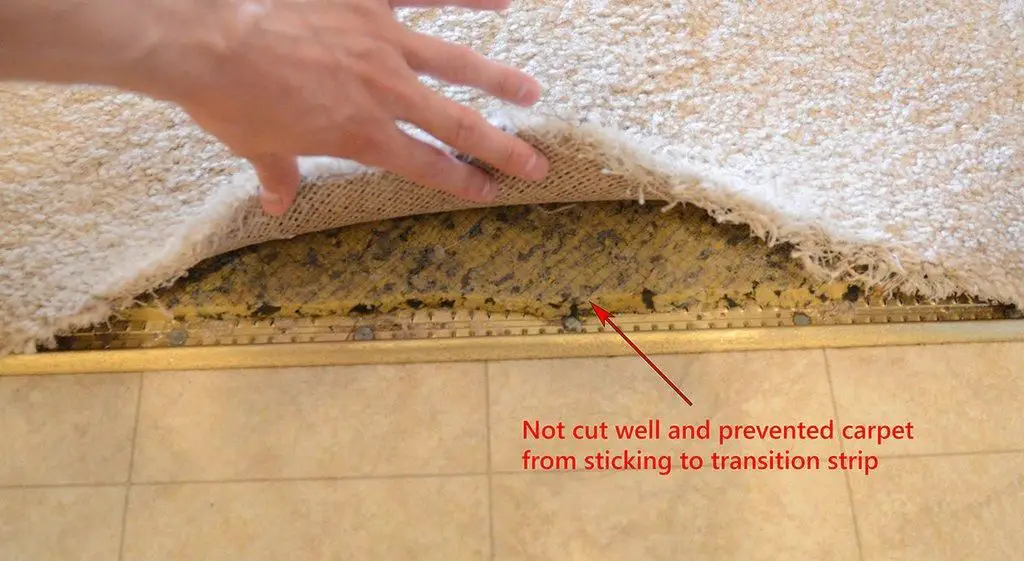Carpets often start to fray or unravel at the edges, especially in high traffic areas like doorways or thresholds. Dealing with a frayed carpet edge can seem daunting, but with the right materials and techniques, it can be an easy DIY fix.
Page Contents
What causes carpet fraying at thresholds?
Fraying and unraveling at the edges of carpets is most often caused by regular foot traffic going over the same area repeatedly. The constant scuffing and friction against the carpet fibers causes them to gradually break down and split apart from the backing, resulting in frayed and unraveled edges.
Thresholds or doorways see some of the highest traffic in a home, as people walk in and out multiple times per day. This makes the carpet right in the doorway prime territory for fraying and unraveling over time. Other high traffic areas like hallways and stairs may also experience fraying for the same reason.
How can you prevent carpet fraying at thresholds?
While some fraying may be inevitable, there are a few preventative steps you can take to prolong the life of your carpet and minimize fraying:
- Use carpet runner mats or area rugs in doorways and other high traffic zones. This protects the underlying carpet from excessive wear.
- Add carpet edge trim or threshold strips made of metal or rubber along the edges and doorways. This creates a sturdy border that prevents fraying.
- Rotate your furniture periodically to distribute wear across the carpet rather than just in main walkways.
- Vacuum frequently using a brush attachment to prevent dirt and debris from abrading the carpet fibers.
- Clip any small frays immediately to prevent further unraveling.
However, despite your best efforts, heavy foot traffic will eventually take its toll and result in frayed edges. When this happens, the ideal solution is to fix the fraying as soon as possible.
How to fix a frayed carpet edge
Here are some simple techniques for repairing a frayed or unraveled section of carpet:
Materials needed
- Scissors
- Seam adhesive or crazy glue
- Heat bond carpet seam tape
- Awl or carpet seam iron (for seam tape)
- Utility knife (for seam tape)
Step 1: Trim the excess fuzz
Use scissors to carefully trim away any long, loose fibers sticking out from the fray. Cut as close to the base of the fray as possible.
Step 2: Apply seam adhesive
Run a thin bead of carpet seam adhesive (or crazy glue) along the frayed edge. Push the fibers back into place, embedding them into the adhesive. Work in small sections, holding the fibers in place for 30-60 seconds as the adhesive sets.
Step 3: Secure with seam tape
For the strongest, longest lasting repair, apply heat bond carpet seam tape:
- Cut a piece of tape a few inches longer than the frayed section.
- Use an awl or carpet seam iron to heat-activate the adhesive side of the tape.
- Position the tape so it overlaps ~1-2 inches onto intact carpet on either side of the fray.
- Press the tape firmly for 30 seconds. Then go over it again with the awl or iron to ensure a good bond.
- Trim excess tape with a utility knife.
The seam tape creates a sturdy border along the edge, reinforcing it and preventing further fraying.
Other carpet fraying fixes
For minor fraying in the middle of a carpet (not along the edge):
- Fray check liquid – Brush on this clear glue to bind and stabilize frays.
- Clear nail polish – Coat the individual fibers to glue them in place.
- Carpet patches – Cut out a small square around the frayed spot and glue in a replacement carpet patch.
When to call a professional
In most cases, DIY methods can easily repair minor to moderate carpet fraying. However, if the frayed section is very large, spans seams, or requires restretching, it may be time to call a professional carpet repair technician. Signs your fraying issue is too big to handle on your own include:
- Fray spans multiple carpet seams
- Significant portion of carpet edge is frayed (more than 10 feet)
- Carpet is loosening or buckling due to fraying
- Room corners are fraying (indicates a restretch is needed)
- Padding is visible beneath frayed section
Professional carpet repair technicians have specialized tools, adhesives, seam tape, and methods for repairing extensive fraying, restretching loose carpet, resecuring seams, and integrating carpet patches. This yields the most seamless, long lasting results.
Conclusion
Keeping carpets from fraying along the edges comes down to preventative maintenance and being vigilant about minor repairs. Use carpet protector mats, trim loose fibers promptly, reinforce edges with tape, and have it professionally restretched when needed. Acting quickly to fix minor fraying helps prevent it from turning into a bigger issue down the road.
